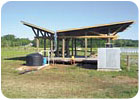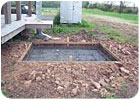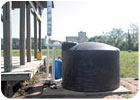
The rainwater harvesting system and cooler.

A concrete pad form with reinforcement was laid and the flume was installed before the rainwater system installed.

Because the first water collected usually is unsuitable for the system, this first-flush device “washes” the roof by sending the first 30 gallons of water straight to the drain.
The system has a small pump outfitted with a pressure tank, pressure switch and float switch to effectively and economically distribute the collected water to where it will be used/needed. This rainwater harvesting system helps to make the CFL more sustainable and demonstrate rainwater collection and utilization techniques for small farmers and homeowners.
For further details on the project, including complete operating instructions and a parts manual, visit www.clemson.edu/scg/sust/project_rainwater.html. ND

Side view of the 1,550-gallon polyethylene cistern.
The following is excerpted from the “Operating Instructions & Parts Manual” that the Clemson University students prepared as part of their rainwater harvesting system project at the university's Calhoun Field Laboratory:
Pump and Accessories
- The pump and pressure switch must be protected from wet weather. Some type of cover is suggested for these items.
- The water entering the pump should not exceed 90 degrees F and should not drop below 32 degrees F. A roof over the tank may need to be erected to prevent direct sunlight from raising the tank temperature drastically during the summer months.
- Do not run pump with the manual cistern drain valve open.
- When draining the tank and pressure lines for winter, the pump also must be drained through the two plugs on pump housing.
- The pressure switch should turn the pump on at 40 psi and off at 60 psi (use mounted pressure gauge for reference). If it fails to meet these requirements, unscrew the pressure switch cover and adjust the two nuts according to the instructions found on the underside of the switch cover.
- The pump, pressure switch and float switch should be hardwired as soon as possible.
- Periodically check diaphragm tank pre-charge pressure with a standard tire pressure gauge. The pressure should read approximately 38 psi.

Blue water well tank that reduces pumping cycles in the rainwater system.
- The tank should be cleaned regularly (skim surface with a fine mesh net to remove debris that may collect). The bottom of the tank may also need to be cleaned periodically. A regular visual inspection through the access port will determine the amount of cleaning that needs to be done.
- Periodically, visually inspect the float switches located on the bottom of the tank near the outlet to make sure they are secured to the cement block. If they are not secured, tie them down in a way that will turn off the pump before the water level reaches the outlet port. This is accomplished by entering the tank after it has been drained. Secure the float cords to the cement block so that the floats will float at the same level. Next hold them both vertical and mimic the action of a falling water level. There will be an audible click at roughly 20 degrees below horizontal. Adjust the height of the floats such that the click is heard before the bottom of the floats reaches the tank outlet port.
- Visually inspect and repair any leaks weekly.
- The system must be drained during freezing weather. First disconnect the power from the pump and accessories. Unscrew the drain plug located just off of the pad in the pressure line and open the hose line valve. Drain the vertical section of pipe from the pump outlet by draining the pump. The drainage lines will drain themselves.
- If water in bottom of flume elbow begins to alter water quality, drill small hole in bottom of flume elbow to drain out onto ground.
Report Abusive Comment